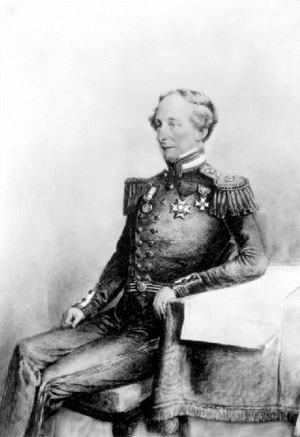Robert Lambert Baynes facts for kids
Quick facts for kids
Sir Robert Baynes
|
|
|---|---|

Rear Admiral Robert Lambert Baynes, 1850s, unknown artist
|
|
| Born | 4 September 1796 Millbrook, Hampshire, England |
| Died | September 7, 1869 (aged 73) Upper Norwood, England |
| Allegiance | |
| Service/ |
|
| Rank | Admiral |
| Commands held | HMS Andromache HMS Bellerophon |
| Battles/wars | Greek War of Independence Crimean War San Juan Boundary Dispute |
| Awards | Knight Commander of the Order of the Bath |
Admiral Sir Robert Lambert Baynes KCB (4 September 1796 – 7 September 1869) was a British Royal Navy admiral. He is famous for preventing a major conflict. In 1859, as the leader of the Pacific Station, he stopped the "Pig War" from becoming a big fight. This dispute was between the United States and the United Kingdom.
Baynes joined the Royal Navy in 1810. He served during the Napoleonic Wars and the War of 1812. He also took part in the Battle of Navarino in 1827. This battle happened during the Greek War of Independence. He became a captain in 1828. Later, he commanded ships like HMS Andromache and HMS Bellerophon. He was also a senior officer in the Baltic Sea during the Crimean War.
Contents
Robert Baynes was born in Millbrook, Hampshire. His father, Thomas Baynes, was also a Commander in the Royal Navy. Robert decided to follow in his father's footsteps.
On April 19, 1810, at just 14 years old, Baynes joined the Royal Navy. His first ship was HMS Blake. This was during the Napoleonic Wars. He served as a midshipman on the ship. They patrolled the coast of Catalonia until 1813.
First Battles and Promotions
From 1813 to 1818, Baynes served on several different ships. These included HMS Duncan and HMS Tonnant. On HMS Seahorse, he fought in the Battle of New Orleans. This battle was part of the War of 1812.
After these experiences, Baynes continued to serve. On April 8, 1818, he was promoted to lieutenant. He later joined HMS Vigo. He also had shore duty at St Helena. Then he joined HMS Briton and HMS Tartarus in South America.
On October 6, 1826, Baynes was assigned to HMS Asia. He was later made commanding officer of HMS Alacrity. But he soon returned to Asia as its second captain. Asia was the main ship for Vice Admiral Edward Codrington.
Baynes was on Asia during the Battle of Navarino. This major battle happened on October 20, 1827. It was part of the Greek War of Independence against the Ottoman Empire. A combined fleet from Britain, France, and Russia attacked a larger Ottoman and Egyptian fleet.
Asia led the attack. The strong firing from the British, French, and Russian ships led to a big victory. Baynes showed great courage during the battle. Because of his bravery, he was promoted to captain on July 8, 1828. He also received several honors, including being made a companion of the Bath.
Leading Ships and Later Service
After becoming a captain, Baynes did not get a command right away. On February 2, 1838, he finally commanded the 26-gun HMS Andromache. He stayed on this ship until March 1843.
From September 23, 1847, to November 7, 1850, he commanded HMS Bellerophon. This ship was a troopship. It served first in the Western Station and then in the Mediterranean. Baynes was promoted to rear admiral on February 7, 1855. He was the third-in-command in the Baltic Sea during the final year of the Crimean War in 1855.
Keeping the Peace in the Pacific
On July 8, 1857, Baynes was given an important role. He became the Commander-in-Chief, Pacific Station. His main ship was HMS Ganges. He arrived during the British Columbia gold rushes. The Royal Navy had to help enforce laws made by Governor James Douglas.
The Gold Rush and San Juan Dispute
While Baynes was away in Peru, a conflict called the San Juan border dispute started. On July 27, 1859, United States troops landed on San Juan Island. This island was off the coast of the Colony of Vancouver Island. The American troops were sent by William Selby Harney.
American settlers claimed they were threatened. They had killed a pig belonging to the Hudson's Bay Company and feared British punishment. San Juan Island was British territory. The British Ambassador, Lord Lyons, told Baynes to help but not to make the situation worse.
Preventing a War
Governor Douglas wanted military action. He demanded that Royal Marines land on the island. But Baynes refused to send troops. He handled the situation very calmly and patiently. His actions led to both countries sharing the island peacefully. They waited until a formal decision could be made. In 1872, Britain agreed that the island belonged to the United States.
After the gold rush and the San Juan dispute, Baynes wanted to move the Pacific Station's headquarters. He suggested Esquimalt in 1859. The Admiralty agreed in 1862.
Later Life and Legacy
On April 18, 1860, Baynes was made a knight commander of the Bath. He remained Commander-in-Chief, Pacific Station until 1861. He then returned to the United Kingdom. He did not hold command again. However, he continued to be promoted. He became vice-admiral of the blue in 1861, vice admiral of the red in 1863, and finally admiral in 1865.
A place in British Columbia called Baynes Sound is named after him. The town of Ganges on Saltspring Island is named after his flagship, Ganges. Sir Robert Lambert Baynes passed away in Upper Norwood on September 7, 1869. He was buried at West Norwood Cemetery.

